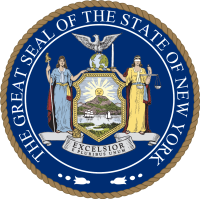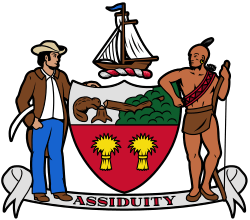New York State Capitol
The New York State Capitol, the seat of the New York State government, is located in Albany, the capital city of the U.S. state of New York. The capitol building is part of the Empire State Plaza complex on State Street in Capitol Park. Housing the New York State Legislature, the building was completed in 1899 at a cost of US$25 million (equivalent to $768 million in 2019), making it the most expensive government building of its time.[3] It was listed on the National Register of Historic Places in 1971, then included as a contributing property when the Lafayette Park Historic District was listed in 1978. The New York State Capitol was declared a National Historic Landmark in 1979.[2][4]
| New York State Capitol | |
|---|---|
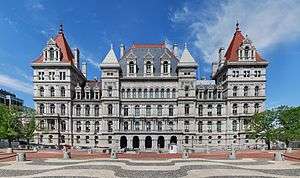 The New York State Capitol viewed from the southwest | |
| General information | |
| Architectural style | Romanesque Revival, Neo-Renaissance |
| Town or city | Albany, New York |
| Country | United States |
| Construction started | 1867 |
| Completed | 1899 |
| Cost | $25 million |
| Client | State of New York |
| Design and construction | |
| Architect | |
New York State Capitol | |
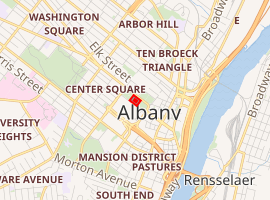
| |
| Built | 1868 |
| Part of | Lafayette Park Historic District (ID78001837) |
| NRHP reference No. | 71000519 |
| Significant dates | |
| Added to NRHP | February 18, 1971[1] |
| Designated NHL | January 29, 1979[2] |
History
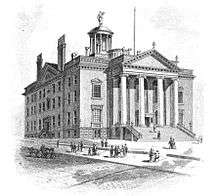
Legislative sessions had been held at different buildings in different places before Albany was declared the State capital in 1797. From that time until 1811, the State Legislature met at the Old Albany City Hall. The first State Capitol was designed by Albany native Philip Hooker, started in 1804, inaugurated in 1812 and remained in use until 1879 when the current building was inaugurated.
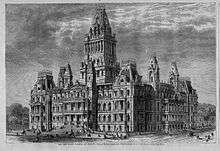
The present Capitol was built between 1867 and 1899. Three teams of architects worked on the design of the Capitol during the 32 years of its construction, managed by: Thomas Fuller (1867–1875), Leopold Eidlitz and Henry Hobson Richardson (1875–1883), and Isaac G. Perry (1883–1899). Fuller, the initial architect, was an Englishman who also designed the Canadian Parliament buildings of Parliament Hill, Ottawa.
The state capitol's ground floor was built in the Classical/Romanesque style. Lieutenant Governor William Dorsheimer then dismissed Fuller in favor of Eidlitz and Richardson who built the next two floors in a Renaissance Classical style, noticeable on the exterior two floors as light, open columnwork. The increasing construction costs became an ongoing source of conflict in the legislature, and it was difficult to secure the necessary funding. Eidlitz and Richardson were dismissed by Grover Cleveland upon his election to governorship and his review of the increasing costs of construction. He hired Perry to complete the project.[5] The legislative chambers, the fourth floor and roof work were all finished in Victorian-modified Romanesque that was distinctively Richardson's design. It "was Richardson who dominated the final outcome of the grand building, which evolved into his distinguished Romanesque style" (which came to be known as Richardsonian Romanesque).[5] It is claimed Richardson was imitating the Hôtel de Ville (City Hall) in Paris, France. The Chazy limestone for its construction was quarried at the Clark Quarry in Essex County, New York.[6]

The central open court is dominated by a shaft intended to support a massive dome. The dome and tower were never completed, as it was found the building's weight was causing stress fractures and making the building shift downhill toward State Street. To stop this movement, a large, 166-foot (51 m) long exterior Eastern Staircase was added to support the front facade. The Capitol exterior is made of white granite from Hallowell, Maine, and the building incorporates Westchester marble cut by state prisoners at Sing Sing. The granite structure is 220 feet (67 m) tall at its highest point, and it is one of eleven U.S. state capitols that does not have a domed roof. Tunnels connect it to the Empire State Plaza and Alfred E. Smith Building. The building's exterior underwent restoration from 2000 until fall 2014.[7][8]
The Assembly Chamber was built with the world's largest open arched span. However, this produced very inconvenient acoustic results. A more serious problem was the structure's shifting foundations that made the vaults unstable. A lower false ceiling was introduced to prevent rock shards from the vaults from falling to the assembly floor.[9]
The Capitol initially featured two large murals by Boston artist William Morris Hunt painted directly on to the Assembly Chamber's sandstone walls. The two enormous works, named The Flight of Night and The Discoverer, each some 45-feet long, were later covered when the Assembly's vaulted ceiling proved unstable and the ceiling was lowered four feet below the murals. Earlier, the murals had been damaged by moisture in the building and had begun to flake. Plans for later murals by Hunt were abandoned due to lack of funding, and some people have speculated the resulting depression experienced by the artist may have contributed to his suicide.[10][11][12]
In front of the Capitol is an equestrian sculpture of Civil War General Philip Sheridan, designed by John Quincy Adams Ward and Daniel Chester French and completed in 1916.[13]
Visiting and tours
The New York State Capitol is open Monday through Friday from 7AM until 7PM. The building is closed most Weekends and Holidays. Official guided tours of the Capitol are Monday through Friday at 10AM, Noon, 2PM and 3PM. Tours begin at the Information Desk located in the State Street Lobby of the Capitol. There is a Visitor Center for the New York State Capitol and Empire State Plaza, located on Concourse Level of the Plaza near the underground entrance to the Capitol. *NEW*: Every second Saturday of the month, the Visitor Center will offer a tour of the Capitol at 11AM and 1PM. Reservations are required and can be made at EmpireStatePlaza.org [14]
Official tour guides offers a special Hauntings Tour during October. The best known alleged-ghost is that of Samuel Abbott, a night watchman who died during a severe fire on March 29, 1911.[15][16] There is also a "demon" carved into the elaborate stonework, supposedly by an angry stoneworker.
Gallery
- View from the southeast
 The Capitol viewed from the west
The Capitol viewed from the west Front view of the Capitol
Front view of the Capitol The Capitol viewed from the Corning Tower
The Capitol viewed from the Corning Tower Panorama of the New York State Assembly Chamber
Panorama of the New York State Assembly Chamber The Governor's Executive Chamber
The Governor's Executive Chamber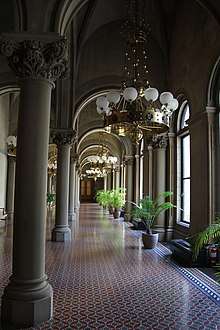 Outside the New York State Senate viewing gallery
Outside the New York State Senate viewing gallery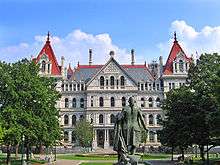 A statue of George Washington northwest of the capitol
A statue of George Washington northwest of the capitol Study for Fortune, a figure in the now-obscured William Morris Hunt murals
Study for Fortune, a figure in the now-obscured William Morris Hunt murals- Flowers outside the capitol building
 The NYS Capitol "Demon"
The NYS Capitol "Demon" The Capitol in 1879
The Capitol in 1879 A rendering of the 1892 plan of the Capitol
A rendering of the 1892 plan of the Capitol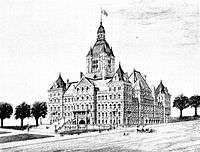 A rendering of the 1893 plan for the Capitol
A rendering of the 1893 plan for the Capitol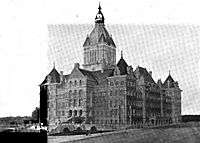 A rendering showing 1897 plan changes
A rendering showing 1897 plan changes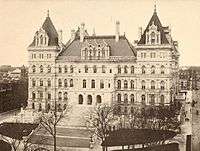 The Capitol in 1900
The Capitol in 1900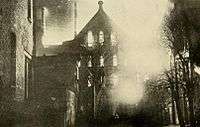 The Capitol on fire in 1911
The Capitol on fire in 1911
See also
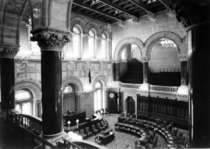 | |
References
- "National Register Information System". National Register of Historic Places. National Park Service. January 23, 2007.
- "New York State Capitol". National Historic Landmark summary listing. National Park Service. Archived from the original on December 27, 2007. Retrieved September 11, 2007.
- "New York State Capitol". WGBH/PBS Online. Retrieved September 26, 2015.
- Carolyn Pitts (January 1979). "National Register of Historic Places Inventory-Nomination: New York State Capitol". National Park Service. Retrieved August 23, 2012. Cite journal requires
|journal=(help) and New York State Capitol exterior undated photo; 289 KiB - "8, Finger Lakes". Historic New York: Architectural Journeys in the Empire State. Landmark Society of Western New York. October 30, 2006. ISBN 978-0-9763910-2-9.
- "Cultural Resource Information System (CRIS)". New York State Office of Parks, Recreation and Historic Preservation. Archived from the original (Searchable database) on July 1, 2015. Retrieved February 1, 2016. Note: This includes William E. Krattinger; Darcey Hale; Bruce Hale & Morris Glenn (August 2012). "National Register of Historic Places Registration Form: Ligonier Point Historic District" (PDF). Retrieved February 1, 2016.
- "Governor Paterson Signs Bill Extending Commission On The Restoration Of The Capitol" (Press release). New York State Office of General Services (OGS). June 4, 2008.
- "Governor Cuomo Announces Completion of Major Restoration Projects at the New York State Capitol" (Press release). OGS. January 4, 2012. Retrieved March 13, 2015.
- "NYS Capitol Assembly Chamber". John G. Waite Associates. Retrieved August 23, 2012.
- "Hunting Ghosts and History at the New York State Capitol". Times Union. Albany. October 27, 2009. Retrieved March 13, 2015.
- "The Horses of Anahita or The Flight of Night". The Metropolitan Museum of Art. Retrieved March 13, 2015.
- Knowlton, Helen M. (2008). Art-Life of William Morris Hunt. READ Books. ISBN 978-1-4437-7391-1.
- "Archived copy". Archived from the original on December 19, 2015. Retrieved September 9, 2015.CS1 maint: archived copy as title (link)
- "Visiting the Empire State Plaza". Office of General Services. Archived from the original on March 10, 2015. Retrieved March 13, 2015.
- "1911 Capitol Fire". New York State Division of Education. Archived from the original on March 11, 2015. Retrieved March 13, 2015.
- Leyden, Liz (October 27, 2011). "Spending a Night With Ghosts Where Legislators Roam". The New York Times. Retrieved October 28, 2011.
- "New York State Capitol". C-SPAN. November 15, 2012. Retrieved March 14, 2013.
Further reading
- Capitol Story, Third Edition, SUNY Press, 2014
External links
| Wikimedia Commons has media related to New York State Capitol. |
- New York State Capitol Virtual Tour
- New York State Capitol at Emporis Buildings
- New York State Capitol at Wonders of the World Databank
- New York State Capitol Tour Program
- New York State Capitol History and Timeline
- Historic American Buildings Survey (HABS) No. NY-404, "New York State Capitol", 2 photos, 1 photo caption page
- New York State Capitol: 30 photos
- New York State Capitol at Structurae
